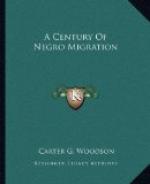The Indiana Farmer, voicing the sentiment of that same community, regretted the increase of this population that seemed to be enlarging the number sent to that territory. The editor insisted that the community which enjoys the benefits of the blacks’ labor should also suffer all the consequences. Since the people of Indiana derived no advantage from slavery, he begged that they be excused from its inconveniences. Most of the blacks that migrated there, moreover, possessed, thought he, “feelings quite unprepared to make good citizens. A sense of inferiority early impressed on their minds, destitute of every thing but bodily power and having no character to lose, and no prospect of acquiring one, even did they know its value, they are prepared for the commission of any act, when the prospect of evading punishment is favorable."[46]
With the exception of such centers as Eden, Upper Alton, Bellville and Chicago, this antagonistic attitude was general also in the State of Illinois. The Negroes were despised, abused and maltreated as persons who had no rights that the white man should respect. Even in Detroit, Michigan, in 1833 a fracas was started by an attack on Negroes. Because a courageous group of them had effected the rescue and escape of one Thornton Blackburn and his wife who had been arrested by the sheriff as alleged fugitives from Kentucky, the citizens invoked the law of 1827, to require free Negroes to produce a certificate and furnish bonds for their behavior and support.[47] The anti-slavery sentiment there, however, was so strong that the law was not long rigidly enforced.[48] And so it was in several other parts of the West which, however, were exceptional.[49]
[Footnote 1: The New York Daily Advertiser, Sept. 22, 1800; The New York Journal of Commerce, July 12, 1834; and The New York Commercial Advertiser, July 12, 1834.]
[Footnote 2: Hart, Slavery and Abolition, pp. 53, 82.]
[Footnote 3: Goodell, American Slave Code, Part III, chap. i; Hurd, The Law of Freedom and Bondage, I, pp. 51, 61, 67, 81, 89, 101, 111; Woodson, The Education of the Negro Prior to 1861, pp. 151-178.]
[Footnote 4: Benezet, Short Observations, p. 12.]
[Footnote 5: Turner, The Negro in Pennsylvania, pp. 143-145.]
[Footnote 6: Journal of House, 1823-24, p. 824.]
[Footnote 7: Journal of House, 1812-1813, pp. 481, 482.]
[Footnote 8: Ibid., 1814-1815, p. 101.]
[Footnote 9: United States Censuses, 1790-1860.]
[Footnote 10: Brannagan, Serious Remonstrances, p. 68.]
[Footnote 11: Turner, The Negro in Pennsylvania, p. 145; The Philadelphia Gazette, June 30, 1819.]
[Footnote 12: Democratic Press, Philadelphia Gazette, Nov. 21, 1825.]
[Footnote 13: Turner, The Negro in Pennsylvania, p. 146.]




